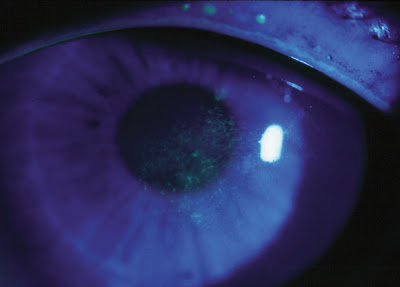Dry Eye Blurry Vision

Many of us suffer from Dry Eyes, but few are aware of the effect it has on our vision. Dry eye can at very least be an annoyance, but at worst it can actually lead to a decrease in vision. In medical terms, dry eye is known as keratoconjunctivitis sicca.
Dry eye occurs when there is a deficiency in the tear film covering the cornea — the eye’s windshield. The cornea is not only our window to the world, it is also the most powerful lens in the eye. If it is damaged or compromised, it affects our vision.
Dry eye does not necessarily mean that your eyes are not wet – in fact, dry eyes can be quite watery (I’ll explain in a bit). Dry eye actually means that the normal composition of the tear film is out of balance. The tear film is essential to the health of the eye, specifically the cornea. It contains an enzyme (lysozyme) that destroys bacteria and then flushes them, and other foreign objects away. But it also contributes to the optical properties of the cornea. Microscopically, the cornea is actually not very smooth. The tear film provides a very smooth and clear optical that optically smooths out the corneal surface. Without a healthy tear film, our cornea could suffer and so too our vision. Good vision requires a healthy cornea, which in turn depends on a healthy tear film.
Most patients with mild dry eye don’t even notice it. This is mainly because dry eye is insidious. In other words, it happens gradually. Until it becomes severe, most patients put up with it as just annoyance. The problem is that a severely dry and inflamed cornea (keratitis sicca) can lead to decreased vision, and with contact lens wear, infection and even corneal ulceration. It literally opens the door to a whole host of problems which can be exacerbated with contact lens use. In fact, in some cases wearing contact lenses will make a very dry eye feel better, while at the same time making it worse! This is because the contact lens acts as a bandage protecting the damaged cornea from the scraping of the eye lids, while at the same time the lens itself draws fluid away from the cornea.

Diseases such as rheumatoid arthritis, graves’ disease, diabetes and scleroderma can also lead to dry eye. Although it can be caused by several factors, dry eye is divided into two types:
- Tear Deficiency – As a result of a lacrimal gland disorder, there are not enough Aqueous tears being produced. The autoimmune condition, Sjogren’s Syndrome, falls under this category.
- Evaporative – This occurs when something, or some combination of factors, throws off the natural balance and chemistry of the tears. Contact lens related dry eye falls under this category.
An examination of the tear film – there’s even an online test(5)(6) – together with the patient’s symptoms are the best indication of a problem. Among the remedies are many dry eye lubricants. There is also an FDA approved medication, Restasis. Patients must take it 6-12 weeks before determining whether or not it is of any benefit to them. Of the over the counter lubricants, however, the heavier gel drops are best. They’re more convenient than ointments and stay in the eye longer than watery drops. They cannot, however, be used while wearing contact lenses. Using a gel drop every night before bed (after removing contacts) is a great way to routinely lubricate the eyes. Some preservatives can actually irritate the eyes. Therefore, it is best to not over use any preserved drop and be aware of any sensitivity. Eliminating contact lens wear completely is certainly ideal for those with dry eye, but as most contact lens wearers will not give them up, it is best to consider the following proactive steps:
- Not wearing contact lenses when reading, studying, or especially while doing heavy computer work.
- Wash your eyelids with warm water every day – there are oil glands in the base of the eyelashes.
- Avoid contact lenses during allergy season if taking medications that can dry the eyes.
- Omega-3s – help reduce inflammation that can contribute to dry eye.
- Hydrate – drink plenty of water and cut back on coffee and alcohol.
- Use a humidifier at home and at the office.
- Remember to blink! (download the blink widget)
(2) http://www.louisvilleeye.org/clin_foulks.html
Foulks G. What is dry eye and what does it mean to the contact lens wearer? Eye & Contact Lens. 2003:29;96-100.
(3) http://www.protectyourvision.org/
(4) http://www.dryeyezone.com/reminders/index.html#
(5) http://www.systane.com/Dry-Eye-Syndrome.aspx
(6) http://www.refreshbrand.com/html/consumer/quiz.asp

